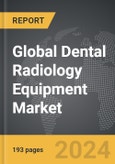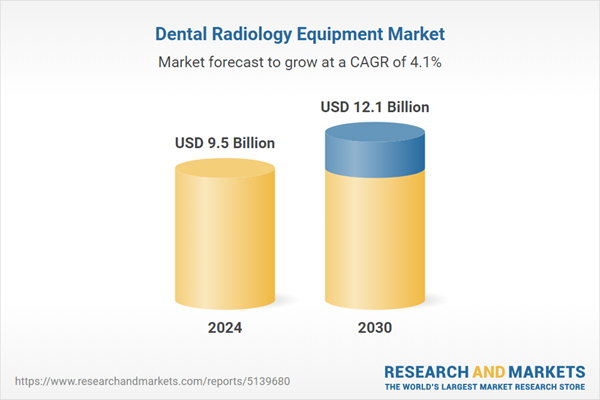The global market for Dental Radiology Equipment was valued at US$9.5 Billion in 2024 and is projected to reach US$12.1 Billion by 2030, growing at a CAGR of 4.1% from 2024 to 2030. This comprehensive report provides an in-depth analysis of market trends, drivers, and forecasts, helping you make informed business decisions. The report includes the most recent global tariff developments and how they impact the Dental Radiology Equipment market.
Segments: Product (Extraoral X-Ray Systems, Intraoral X-Ray Systems, Cone-Beam Computed Tomography Imaging, Intraoral Plate Scanners); End-Use (Dental Clinics, Hospital, Ambulatory Surgery Centers).
Geographic Regions/Countries: World; United States; Canada; Japan; China; Europe (France; Germany; Italy; United Kingdom; and Rest of Europe); Asia-Pacific; Rest of World.
The analysts continuously track trade developments worldwide, drawing insights from leading global economists and over 200 industry and policy institutions, including think tanks, trade organizations, and national economic advisory bodies. This intelligence is integrated into forecasting models to provide timely, data-driven analysis of emerging risks and opportunities.
Global Dental Radiology Equipment Market - Key Trends and Drivers Summarized
What Is Dental Radiology Equipment and How Does It Enhance Dental Care?
Dental radiology equipment plays a critical role in modern dentistry, providing detailed images of teeth, gums, and jaw bones that help dentists diagnose and treat conditions with greater accuracy and effectiveness. This equipment ranges from traditional X-ray machines to more advanced digital systems, including cone-beam computed tomography (CBCT) systems that produce 3D images. These tools are indispensable for a variety of diagnostic tasks, such as identifying cavities, examining the health of the bone around the teeth, checking the status of developing teeth, and planning for dental implants. Enhanced imaging capabilities allow for early detection of potential issues, leading to more timely and effective interventions, ultimately improving patient outcomes and satisfaction.What Advancements Have Been Made in Dental Radiology Equipment?
Over the years, significant advancements in dental radiology equipment have centered around improving the clarity of images, reducing exposure to radiation, and enhancing user and patient comfort. Modern digital X-ray systems use sensors instead of traditional photographic film, which not only reduces radiation exposure by up to 90% but also provides instant images that can be digitally stored and easily shared among healthcare providers. The development of CBCT technology has been a major leap forward, offering 3D imaging that is especially useful in complex cases involving surgery, highly detailed diagnostics, and treatment planning. Innovations in software applications that accompany these hardware advancements allow for better image manipulation and integration with other digital health records, enhancing diagnostic accuracy and treatment planning.What Challenges Are Associated with Dental Radiology Equipment?
Despite its numerous benefits, the use of dental radiology equipment presents several challenges. The high cost of advanced imaging systems can be a significant barrier for smaller dental practices or those in developing regions. Furthermore, the complexity of some new technologies requires comprehensive training for dental practitioners, which can be time-consuming and expensive. There are also concerns about the long-term health effects of radiation exposure for patients, particularly those who require frequent imaging. This has necessitated the development of stricter guidelines and regulations regarding the use of radiographic equipment in dentistry to ensure patient safety without compromising diagnostic capabilities.What Drives the Growth in the Dental Radiology Equipment Market?
The growth in the dental radiology equipment market is driven by several factors, beginning with the increasing global emphasis on preventive dental care and the growing awareness of oral health's impact on overall health. As dental diseases continue to be prevalent, the need for advanced diagnostic tools that offer early detection and detailed imaging increases. Technological advancements that provide clearer images, enhanced features, and reduced radiation doses are also significant contributors to market expansion. Additionally, the integration of dental health records with general health information systems demands digital solutions that dental radiology equipment can provide. Economic growth in emerging markets is increasing access to healthcare, subsequently driving demand for dental services and the equipment necessary to support them. Together, these factors ensure a dynamic and growing market for dental radiology equipment, reflecting broader trends towards enhanced healthcare infrastructure and preventive care in dentistry.Report Scope
The report analyzes the Dental Radiology Equipment market, presented in terms of units. The analysis covers the key segments and geographic regions outlined below.Segments: Product (Extraoral X-Ray Systems, Intraoral X-Ray Systems, Cone-Beam Computed Tomography Imaging, Intraoral Plate Scanners); End-Use (Dental Clinics, Hospital, Ambulatory Surgery Centers).
Geographic Regions/Countries: World; United States; Canada; Japan; China; Europe (France; Germany; Italy; United Kingdom; and Rest of Europe); Asia-Pacific; Rest of World.
Key Insights:
- Market Growth: Understand the significant growth trajectory of the Extraoral X-Ray Systems segment, which is expected to reach US$6.3 Billion by 2030 with a CAGR of a 5.1%. The Intraoral X-Ray Systems segment is also set to grow at 3.8% CAGR over the analysis period.
- Regional Analysis: Gain insights into the U.S. market, valued at $2.6 Billion in 2024, and China, forecasted to grow at an impressive 3.8% CAGR to reach $1.9 Billion by 2030. Discover growth trends in other key regions, including Japan, Canada, Germany, and the Asia-Pacific.
Why You Should Buy This Report:
- Detailed Market Analysis: Access a thorough analysis of the Global Dental Radiology Equipment Market, covering all major geographic regions and market segments.
- Competitive Insights: Get an overview of the competitive landscape, including the market presence of major players across different geographies.
- Future Trends and Drivers: Understand the key trends and drivers shaping the future of the Global Dental Radiology Equipment Market.
- Actionable Insights: Benefit from actionable insights that can help you identify new revenue opportunities and make strategic business decisions.
Key Questions Answered:
- How is the Global Dental Radiology Equipment Market expected to evolve by 2030?
- What are the main drivers and restraints affecting the market?
- Which market segments will grow the most over the forecast period?
- How will market shares for different regions and segments change by 2030?
- Who are the leading players in the market, and what are their prospects?
Report Features:
- Comprehensive Market Data: Independent analysis of annual sales and market forecasts in US$ Million from 2024 to 2030.
- In-Depth Regional Analysis: Detailed insights into key markets, including the U.S., China, Japan, Canada, Europe, Asia-Pacific, Latin America, Middle East, and Africa.
- Company Profiles: Coverage of players such as ACTEON North America, Carestream Health, Inc., Danaher Corporation, Dentsply Sirona, Midmark Corporation and more.
- Complimentary Updates: Receive free report updates for one year to keep you informed of the latest market developments.
Some of the 44 companies featured in this Dental Radiology Equipment market report include:
- ACTEON North America
- Carestream Health, Inc.
- Danaher Corporation
- Dentsply Sirona
- Midmark Corporation
- Planmeca Oy
- Vatech Co., Ltd.
Tariff Impact Analysis: Key Insights for 2025
Global tariff negotiations across 180+ countries are reshaping supply chains, costs, and competitiveness. This report reflects the latest developments as of April 2025 and incorporates forward-looking insights into the market outlook.The analysts continuously track trade developments worldwide, drawing insights from leading global economists and over 200 industry and policy institutions, including think tanks, trade organizations, and national economic advisory bodies. This intelligence is integrated into forecasting models to provide timely, data-driven analysis of emerging risks and opportunities.
What’s Included in This Edition:
- Tariff-adjusted market forecasts by region and segment
- Analysis of cost and supply chain implications by sourcing and trade exposure
- Strategic insights into geographic shifts
Buyers receive a free July 2025 update with:
- Finalized tariff impacts and new trade agreement effects
- Updated projections reflecting global sourcing and cost shifts
- Expanded country-specific coverage across the industry
Table of Contents
I. METHODOLOGYII. EXECUTIVE SUMMARY2. FOCUS ON SELECT PLAYERSIII. MARKET ANALYSISIV. COMPETITION
1. MARKET OVERVIEW
3. MARKET TRENDS & DRIVERS
4. GLOBAL MARKET PERSPECTIVE
UNITED STATES
CANADA
JAPAN
CHINA
EUROPE
FRANCE
GERMANY
ITALY
UNITED KINGDOM
REST OF EUROPE
ASIA-PACIFIC
REST OF WORLD
Companies Mentioned (Partial List)
A selection of companies mentioned in this report includes, but is not limited to:
- ACTEON North America
- Carestream Health, Inc.
- Danaher Corporation
- Dentsply Sirona
- Midmark Corporation
- Planmeca Oy
- Vatech Co., Ltd.
Table Information
| Report Attribute | Details |
|---|---|
| No. of Pages | 193 |
| Published | April 2025 |
| Forecast Period | 2024 - 2030 |
| Estimated Market Value ( USD | $ 9.5 Billion |
| Forecasted Market Value ( USD | $ 12.1 Billion |
| Compound Annual Growth Rate | 4.1% |
| Regions Covered | Global |









